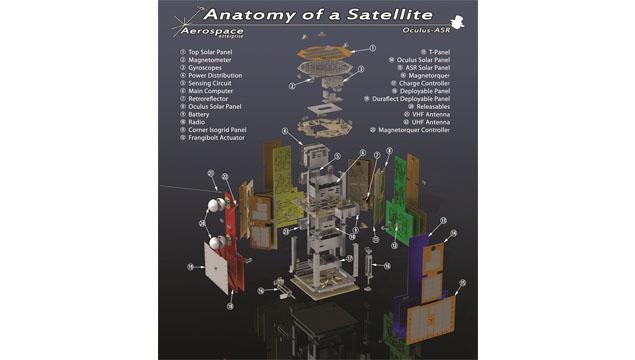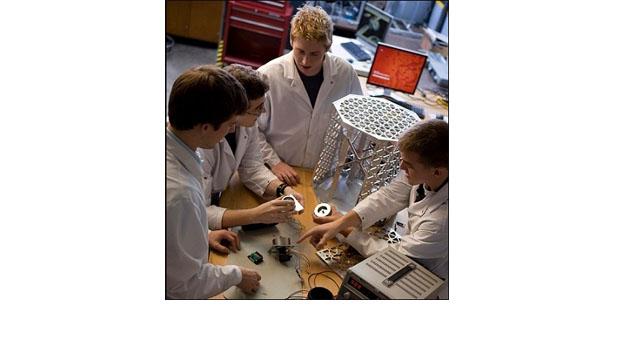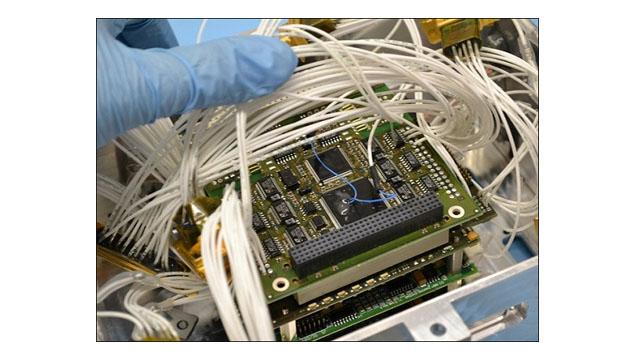Oculus-ASR Nanosatellite
Why This Project Is Important
The Oculus-ASR project is important for two main reasons. First, as part of the Aerospace Enterprise, it is a real-world project designed to train future leaders of the aerospace industry. Through the students' contacts with industry partners and their exposure to system and requirement driven design, aerospace standards, and mission analysis, they will upon graduation have a skill set that is highly desired in industry and research institutions. The entire vehicle was designed and will be constructed and tested by undergraduate students.
Secondly, the mission of Oculus-ASR is important in advancing the technology that can identify unknown space objects and, if it is a space vehicle, predict its mission. Imagine an unfriendly organization's satellite stationed over the US. Because it was most likely launched in secret, we do not know what it is doing - but we think it has malicious intent. Fortunately, all we have to do is point a telescope at it, observe its optical signature, and from their, analyze its shape and, eventually, its mission. Oculus-ASR will provide the Department of Defense the capability to identify space objects, determine their shape, and predict their intent. Oculus-ASR is a calibration tool for these telescopes and the computer programs necessary to create the vehicle's shape.
Project Description
The Aerospace Enterprise is an undergraduate student organization at Michigan Technological University where students from all academic programs, across campus, work to design and build a satellite that will be launched into space.
As an entrant in the Air Force Research Lab’s sixth University Nanosatellite competition, students in Michigan Technological University’s Aerospace Enterprise were awarded the opportunity to launch Oculus-ASR into low-earth orbit in 2016. The University Nanosatellite Program (UNP) competition operates on a two-year cycle consisting of mission and system requirement formation, spacecraft design reviews with Air Force personnel, and hands-on satellite construction workshops. After the two year competition cycle ended in 2010, Michigan Tech students presented the Oculus-ASR mission and a prototype vehicle to the Air Force Research Lab (AFRL) and aerospace professionals. Because of the mission viability and practicality, students’ project documentation, and the steady progress over the course of the program, the Oculus-ASR project team won the competition and was selected to receive continued AFRL support.
The mission of Oculus-ASR is important to the AFRL and Department of Defense’s goal of increasing space situational awareness and developing a full catalogue of objects in orbit. Space situational awareness is comprised of three parts of an orbiting object: what, where, and why. Current tracking methods such as the radar dome or “space fence” provide fairly accurate information on the size of objects in near-space and its orbital characteristics (such as trajectory, velocity, ground track, and altitude). While this information can be combined with rocket launch manifests to develop an accurate model of objects in orbit, some launches are kept secret by various governments around the world. Determining the what and why of non-US satellites and the intent of their operators is a critical step in maintaining national security and protecting our space assets. The form and behavior of a spacecraft are closely related to mission objectives. There are a few ways available to determine spacecraft intent, but none as accurate and easily accessible as an observation of a satellite’s form and attitude profile by a mission analyst. The mission of the Oculus-ASR nanosatellite is to aid in calibration of algorithms and a global array of telescopes that, using unresolved optical imagery, can determine spacecraft attitude and configuration. By focusing a telescope fitted with spectral analysis equipment, low resolution images of multiple spacecraft can be recorded and fed into an algorithm being developed by the Air Force Research Lab at their Maui observatory. With a functioning algorithm, observatories stationed around the world will be able to develop models predicting satellites’ shape and attitude profiles based on the spectral data, providing analysts with the necessary information to interpret a satellite’s mission. The Oculus-ASR is an excellent tool to perform the calibration of such algorithms and to test the system’s ability to determine attitude and spacecraft form. Before the Oculus-ASR, no mission has been devoted fully to this task.
During the mission campaigns, Michigan Tech students will operate the satellite using an internet-based ground station and a transceiver in Ann Arbor, Michigan. As Oculus-ASR passes over the Maui Observatory, students will be able to command the satellite to perform maneuvers such as pointing a particular face at the earth, releasing a highly-reflective sphere, or deploying one of the four solar panels. These are all valuable maneuvers that allow Oculus-ASR to change its configuration or attitude state while in orbit, simulating what could be a change of intent or a development in a malicious mission from an unfriendly organization. Equally important as changing its shape, Oculus-ASR has the ability to record attitude truth data--an accurate record of the spacecraft’s actual orientation in space--which can then be transmitted to the Maui observatory to compare to the output of the attitude and shape recovery algorithms.
Meet the Researcher

days left
funded
last
What Your Donation Can Help Us Do:
- Purchase or support the hardware that will actually fly in space!
- Cover the travel expenses for students attending the Air Force's Student Hands-On Training workshop or the annual Small-Sat conference.
- Upgrade the equipment to models similar to what is used in industry and research labs.
$1+ 25 Funders
A personalized thank-you indicating your tax-sheltered contribution
$25+ 25 Funders
Be listed on our website as a mission sponsor, plus all of the above
$50+ 23 Funders
Receive an Oculus-ASR collector photo, plus all of the above
$200+ 9 Funders
Receive a Michigan Tech hat, plus all of the above
$500+ 4 Funders
Receive a 3-D printed model of the Oculus-ASR, plus all of the above
$1,000+ 0 Funders
Receive a Michigan Tech Aerospace Enterprise polo, plus all of the above
Recent Donors
Some donors may be hidden.




 Gifts to projects listed on SUPERIORIDEAS.ORG are received and processed by Michigan Tech Fund. Michigan Tech Fund is a tax-exempt organization under Section 501(c)(3) of the Internal Revenue Code acting on behalf of Michigan Technological University. It is the policy of Michigan Tech Fund that a portion of the gifts and/or income therefrom may be used to defray the costs of raising and administering the funds.
Gifts to projects listed on SUPERIORIDEAS.ORG are received and processed by Michigan Tech Fund. Michigan Tech Fund is a tax-exempt organization under Section 501(c)(3) of the Internal Revenue Code acting on behalf of Michigan Technological University. It is the policy of Michigan Tech Fund that a portion of the gifts and/or income therefrom may be used to defray the costs of raising and administering the funds.